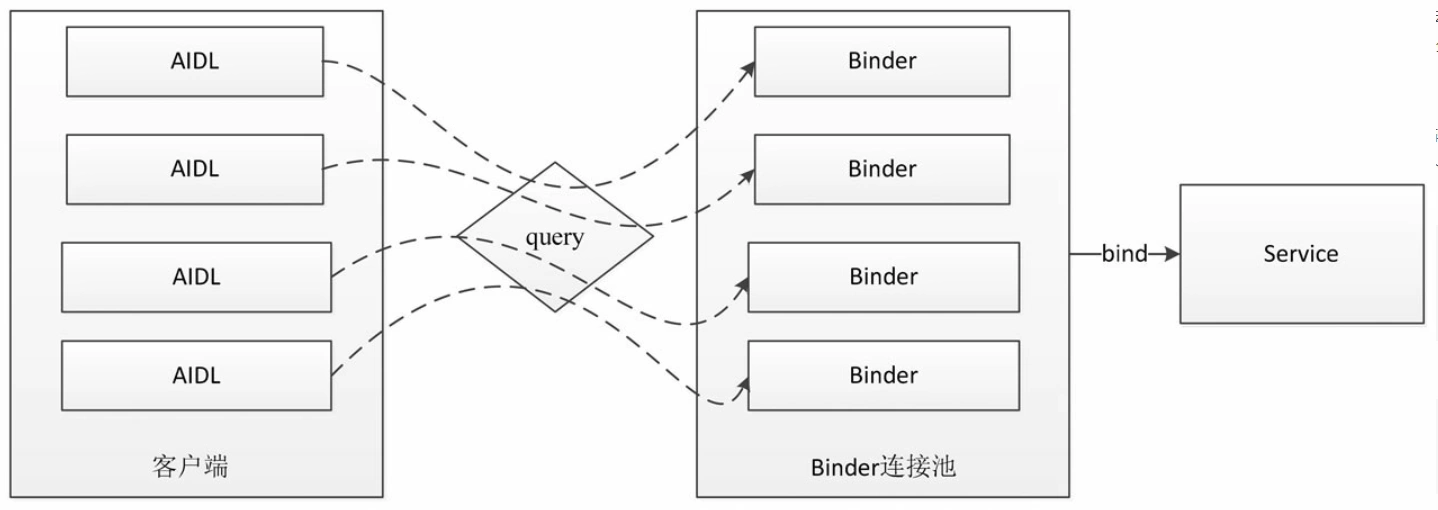Binder连接池
原文链接Android开发艺术探索
上面我们介绍了不同的IPC方式,我们知道,不同的IPC方式有不同的特点和适用场景,当然这个问题会在2.6节进行介绍,在本节中要再次介绍一下ADIL,原因是AIDL是一种最常用的进程间通信方式,是日常开发中涉及进程间通信时的首选,所以我们需要额外强调一下它。
使用AIDL的大致流程:首先创建一个Service和一个AIDL接口,接着创建一个类继承自AIDL接口中的Stub类并实现Stub中的抽象方法,在Service的onBind方法中返回这个类的对象,然后客户端就可以绑定服务端Service,建立连接后就可以访问远程服务端的方法了。
上述过程就是典型的AIDL的使用流程。这本来也没什么问题,但是现在考虑一种情况:公司的项目越来越庞大了,现在有10个不同的业务模块都需要使用AIDL来进行进程间通信,那我们该怎么处理呢?也许你会说:“就按照AIDL的实现方式一个个来吧”,这是可以的,如果用这种方法,首先我们需要创建10个Service,这好像有点多啊!如果有100个地方需要用到AIDL呢,先创建100个Service?到这里,读者应该明白问题所在了。
随着AIDL数量的增加,我们不能无限制地增加Service, Service是四大组件之一,本身就是一种系统资源。而且太多的Service会使得我们的应用看起来很重量级,因为正在运行的Service可以在应用详情页看到,当我们的应用详情显示有10个服务正在运行时,这看起来并不是什么好事。针对上述问题,我们需要减少Service的数量,将所有的AIDL放在同一个Service中去管理。
在这种模式下,整个工作机制是这样的:每个业务模块创建自己的AIDL接口并实现此接口,这个时候不同业务模块之间是不能有耦合的,所有实现细节我们要单独开来,然后向服务端提供自己的唯一标识和其对应的Binder对象;对于服务端来说,只需要一个Service就可以了,服务端提供一个queryBinder接口,这个接口能够根据业务模块的特征来返回相应的Binder对象给它们,不同的业务模块拿到所需的Binder对象后就可以进行远程方法调用了。由此可见,Binder连接池的主要作用就是将每个业务模块的Binder请求统一转发到远程Service中去执行,从而避免了重复创建Service的过程,它的工作原理如图所示。

通过上面的理论介绍,也许还有点不好理解,下面对Binder连接池的代码实现做一下说明。
首先,为了说明问题,我们提供了两个AIDL接口(ISecurityCenter和ICompute)来模拟上面提到的多个业务模块都要使用AIDL的情况,其中ISecurityCenter接口提供加解密功能,声明如下:
package com.ryg.chapter_2.binderpool;
interface ISecurityCenter {
String encrypt(String content);
String decrypt(String password);
}而ICompute接口提供计算加法的功能,声明如下:
package com.ryg.chapter_2.binderpool;
interface ICompute {
int add(int a, int b);
}虽然说上面两个接口的功能都比较简单,但是用于分析Binder连接池的工作原理已经足够了,读者可以写出更复杂的例子。
接着看一下上面两个AIDL接口的实现,也比较简单,代码如下:
SecurityCenterImpl.java
package com.ryg.chapter_2.binderpool;
import android.os.RemoteException;
public class SecurityCenterImpl extends ISecurityCenter.Stub {
private static final char SECRET_CODE = '^';
@Override
public String encrypt(String content) throws RemoteException {
char[] chars = content.toCharArray();
for (int i = 0; i < chars.length; i++) {
chars[i] ^= SECRET_CODE;//相当于chars[i] = chars[i]^SECRET_CODE
}
return new String(chars);
}
@Override
public String decrypt(String password) throws RemoteException {
return encrypt(password);
}
}ComputeImpl.java
package com.ryg.chapter_2.binderpool;
import android.os.RemoteException;
public class ComputeImpl extends ICompute.Stub {
@Override
public int add(int a, int b) throws RemoteException {
return a + b;
}
}现在业务模块的AIDL接口定义和实现都已经完成了,注意这里并没有为每个模块的AIDL单独创建Service,
接下来就是服务端和Binder连接池的工作了。
首先,为Binder连接池创建AIDL接口IBinderPool.aidl,代码如下所示。
package com.ryg.chapter_2.binderpool;
interface IBinderPool {
/**
* @param binderCode, the unique token of specific Binder<br/>
* @return specific Binder who's token is binderCode.
*/
IBinder queryBinder(int binderCode);
}接着,为Binder连接池创建远程Service并实现IBinderPool,下面是queryBinder的具体实现,可以看到请求转发的实现方法,当Binder连接池连接上远程服务时,会根据不同模块的标识即binderCode返回不同的Binder对象,通过这个Binder对象所执行的操作全部发生在远程服务端。
@Override
public IBinder queryBinder(int binderCode) throws RemoteException {
IBinder binder = null;
switch (binderCode) {
case BINDER_SECURITY_CENTER: {
binder = new SecurityCenterImpl ();
break;
}
case BINDER_COMPUTE: {
binder = new ComputeImpl ();
break;
}
default:
break;
}
return binder;
}远程Service的实现就比较简单了,代码如下所示。
BinderPoolService.java
package com.ryg.chapter_2.binderpool;
public class BinderPoolService extends Service {
private static final String TAG = "BinderPoolService";
/**
* 在服务端创建一个连接池,BinderPoolImpl是BinderPool的内部类,
* 它继承了IBinderPool.Stub,并实现了queryBinder方法。
*/
private Binder mBinderPool = new BinderPool.BinderPoolImpl ();
@Override
public void onCreate() {
super.onCreate ();
}
@Override
public IBinder onBind(Intent intent) {
Log.d (TAG, "onBind");
return mBinderPool;//返回连接池对象
}
@Override
public void onDestroy() {
super.onDestroy ();
}
}下面还剩下Binder连接池的具体实现,在它的内部首先它要去绑定远程服务,绑定成功后,客户端就可以通过它的queryBinder方法去获取各自对应的Binder,拿到所需的Binder以后,不同业务模块就可以进行各自的操作了,Binder连接池的代码如下所示。
BinderPool.java
package com.ryg.chapter_2.binderpool;
import java.util.concurrent.CountDownLatch;
public class BinderPool {
private static final String TAG = "BinderPool";
public static final int BINDER_NONE = -1;
public static final int BINDER_COMPUTE = 0;
public static final int BINDER_SECURITY_CENTER = 1;
private Context mContext;
private IBinderPool mBinderPool;
private static volatile BinderPool sInstance;
private CountDownLatch mConnectBinderPoolCountDownLatch;
private BinderPool(Context context) {
mContext = context.getApplicationContext ();
connectBinderPoolService ();
}
//返回BinderPool的实例,如果没有的话就创建,有的话就直接返回。
public static BinderPool getInsance(Context context) {
if (sInstance == null) {
synchronized (BinderPool.class) {
if (sInstance == null) {
sInstance = new BinderPool (context);
}
}
}
return sInstance;
}
//连接BinderPoolService服务器。 CountDownLatch将bindService这一异步操作转换成了同步操作
private synchronized void connectBinderPoolService() {
mConnectBinderPoolCountDownLatch = new CountDownLatch (1);
Intent service = new Intent (mContext, BinderPoolService.class);
mContext.bindService (service, mBinderPoolConnection,
Context.BIND_AUTO_CREATE);
try {
mConnectBinderPoolCountDownLatch.await ();
} catch (InterruptedException e) {
e.printStackTrace ();
}
}
/**
* query binder by binderCode from binder pool
*
* @param binderCode the unique token of binder
* @return binder who's token is binderCode<br>
* return null when not found or BinderPoolService died.
*/
public IBinder queryBinder(int binderCode) {
IBinder binder = null;
try {
/*这个mBinderPool是一个BinderPool.BinderPoolImpl对象。
对于客户端来说调用的是BinderPool的queryBinder方法,
而BinderPool的queryBinder方法又调用了BinderPool.BinderPoolImpl对象的queryBinder方法。
mBinderPool这个对象是服务端返回给BinderPool的,对客户端是隐藏的,客户端只知道BinderPool,
mBinderPool是服务端和连接池的桥梁,
BinderPool是客户端和连接池的桥梁*/
if (mBinderPool != null) {
binder = mBinderPool.queryBinder (binderCode);
}
} catch (RemoteException e) {
e.printStackTrace ();
}
return binder;
}
//连接服务器的时候用的,里面有连接成功和连接断开后的操作。
private ServiceConnection mBinderPoolConnection = new ServiceConnection () {
@Override
public void onServiceDisconnected(ComponentName name) {
// ignored.
}
@Override
public void onServiceConnected(ComponentName name, IBinder service) {
/*
* 将服务器端的Binder转换成客户端所需的AIDL接口对象:
* 服务端返回的是BinderPool连接池,而不是单纯的一个Binder对象。
* */
mBinderPool = IBinderPool.Stub.asInterface (service);
try {
//设置死亡代理:
mBinderPool.asBinder ().linkToDeath (mBinderPoolDeathRecipient, 0);
} catch (RemoteException e) {
e.printStackTrace ();
}
mConnectBinderPoolCountDownLatch.countDown ();
}
};
//设置死亡代理:
private IBinder.DeathRecipient mBinderPoolDeathRecipient = new IBinder.DeathRecipient () {
@Override
public void binderDied() {
Log.w (TAG, "binder died.");
mBinderPool.asBinder ().unlinkToDeath (mBinderPoolDeathRecipient, 0);
mBinderPool = null;
connectBinderPoolService ();
}
};
/*
* (1)这个是我们的Binder连接池,它源于IBinderPool.aidl这个AIDL,它里面包含一个queryBinder方法,
* 我们的Binder连接池是放在服务端用,
* 所以在服务端需要有这样一个BinderPoolImpl的实例,并且它是一个Binder:
* private Binder mBinderPool = new BinderPool.BinderPoolImpl();
* (2)那怎么用呢?
* 我们当前所在的类BinderPool.java就是用来绑定服务端的客户端,
* 在BinderPool绑定服务端的时候,服务端会将mBinderPool返回给客户端也就是我们这个类,
* 然后我们可以根据服务端返回的这个Binder来转换成客户端所需的AIDL接口对象,还是叫mBinderPool,
* 然后我们这个类中就可以调用mBinderPool中的方法:
* binder = mBinderPool.queryBinder(binderCode);
* (3)那另外的两个AIDL呢?ICompute.aidl和ISecurityCenter.aidl呢?
* 由于另外的两个AIDL的使用都是和服务端相关联的,是服务端的queryBinder方法将它们的Binder返回给客户端的,
* 客户端接到这两个AIDL的Binder以后,依旧是通过转换成AIDL接口对象来使用这两个AIDL中的方法的。
* */
public static class BinderPoolImpl extends IBinderPool.Stub {
public BinderPoolImpl() {
super ();
}
@Override
public IBinder queryBinder(int binderCode) throws RemoteException {
IBinder binder = null;
switch (binderCode) {
case BINDER_SECURITY_CENTER: {
binder = new SecurityCenterImpl ();
break;
}
case BINDER_COMPUTE: {
binder = new ComputeImpl ();
break;
}
default:
break;
}
return binder;
}
}
}Binder连接池的具体实现就分析完了,它的好处是显然易见的,针对上面的例子,我们只需要创建一个Service即可完成多个AIDL接口的工作,下面我们来验证一下效果。新创建一个Activity,在线程中执行如下操作:
package com.ryg.chapter_2.binderpool;
//这里是客户端
public class BinderPoolActivity extends Activity {
private static final String TAG = "BinderPoolActivity";
private ISecurityCenter mSecurityCenter;
private ICompute mCompute;
@Override
protected void onCreate(Bundle savedInstanceState) {
super.onCreate(savedInstanceState);
setContentView(R.layout.activity_binder_pool);
//在线程中去执行:另开启一个线程执行,因为在binder连接池的实现中,通过CountDownLatch将bindeService
//异步操作转换成了同步操作,意味着有可能是耗时的而且binder方法的调用过程可能也是耗时的
new Thread(new Runnable() {
@Override
public void run() {
doWork();
}
}).start();
}
private void doWork() {
// 首先获取一个BinderPool的实例:这里是带了上下文的,避免创建多个。
BinderPool binderPool = BinderPool.getInsance(BinderPoolActivity.this);
/*
* 然后根据客户端编号bindercode查询Binder,返回的是对应的客户端的Binder。
* 在binderPool.queryBinder中,是根据在绑定服务端过程中返回的BinderPoolImpl的Binder,
* 这个BinderPoolImpl就是继承了IBinderPool的,所以也实现了其中的queryBinder的。
* 这样返回的才是真正对应的securityBinder。
* */
IBinder securityBinder = binderPool
.queryBinder(BinderPool.BINDER_SECURITY_CENTER);
//查到对应的Binder以后,就可以根据这个Binder来转换成客户端所需的AIDL接口对象:
mSecurityCenter = (ISecurityCenter) SecurityCenterImpl
.asInterface(securityBinder);
Log.d(TAG, "visit ISecurityCenter");
String msg = "helloworld-安卓";
System.out.println("content:" + msg);
try {
//有了接口对象,自然就可以调用对象中的方法了:
String password = mSecurityCenter.encrypt(msg);
System.out.println("encrypt:" + password);
System.out.println("decrypt:" + mSecurityCenter.decrypt(password));
} catch (RemoteException e) {
e.printStackTrace();
}
//下面这是另一个AIDL模块,使用方法和上面是一样的。
Log.d(TAG, "visit ICompute");
IBinder computeBinder = binderPool
.queryBinder(BinderPool.BINDER_COMPUTE);
mCompute = ComputeImpl.asInterface(computeBinder);
try {
System.out.println("3+5=" + mCompute.add(3, 5));
} catch (RemoteException e) {
e.printStackTrace();
}
}
}在上述代码中,我们先后调用了ISecurityCenter和ICompute这两个AIDL接口中的方法,看一下log,很显然,工作正常。
D/BinderPoolActivity(20270): visit ISecurityCenter
I/System.out(20270): content:helloworld-安卓
I/System.out(20270): encrypt:6;221)1,2:s寗匍
I/System.out(20270): decrypt:helloworld-安卓
D/BinderPoolActivity(20270): visit ICompute
I/System.out(20270): 3+5=8这里需要额外说明一下,为什么要在线程中去执行呢?
这是因为在Binder连接池的实现中,我们通过CountDownLatch将bindService这一异步操作转换成了同步操作,这就意味着它有可能是耗时的,然后就是Binder方法的调用过程也可能是耗时的,因此不建议放在主线程去执行。
注意到BinderPool是一个单例实现,因此在同一个进程中只会初始化一次,所以如果我们提前初始化BinderPool,那么可以优化程序的体验,比如我们可以放在Application中提前对BinderPool进行初始化,虽然这不能保证当我们调用BinderPool时它一定是初始化好的,但是在大多数情况下,这种初始化工作(绑定远程服务)的时间开销(如果BinderPool没有提前初始化完成的话)是可以接受的。
另外,BinderPool中有断线重连的机制,当远程服务意外终止时,BinderPool会重新建立连接,这个时候如果业务模块中的Binder调用出现了异常,也需要手动去重新获取最新的Binder对象,这个是需要注意的。
有了BinderPool可以大大方便日常的开发工作,比如如果有一个新的业务模块需要添加新的AIDL,那么在它实现了自己的AIDL接口后,只需要修改BinderPoolImpl中的queryBinder方法,给自己添加一个新的binderCode(比如上面的BINDER_SECURITY_CENTER和BINDER_COMPUTE)并返回对应的Binder对象即可,不需要做其他修改,也不需要创建新的Service。由此可见,BinderPool能够极大地提高AIDL的开发效率,并且可以避免大量的Service创建,因此,建议在AIDL开发工作中引入BinderPool机制。